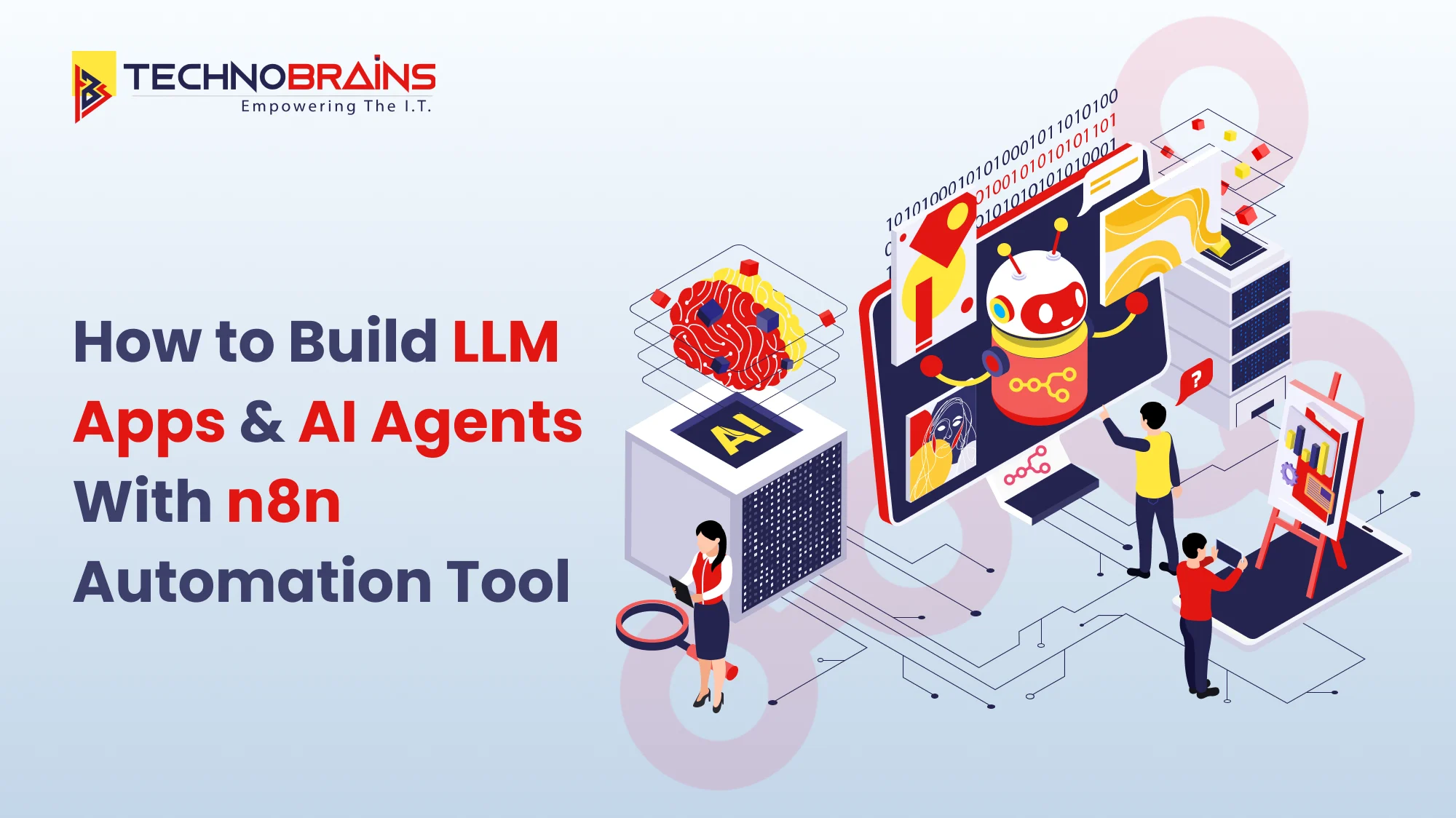Get 40 Hours Free Developer Trial
Test Our Developers for 40 Hours at No Cost - Start Your Free Trial →
Did you know that around 51% companies now use n8n AI agents in their production systems?
Think about automating complicated tasks that need people to step in, like researching topics, summarizing insights, and storing them straight into your work tools. That’s exactly what AI agents can provide. Businesses that use these smart tools have seen response times drop by half or more and 40% lower support costs while keeping response quality high.
What is n8n and Why Use it?
n8n (n-eight-n) is a powerful open-source platform to automate workflows, connecting apps, services, and APIs using a visual interface. It lets you design workflows to link your go-to tools and use AI features. The coolest thing about n8n is that whether you’re a business user or part of a technical team, you do not need to be a coding expert to get started.
Why n8n stands apart from other automation tools:
- You control your data with self-hosting options.
- A visual, node-based design helps you build complex workflows.
- It supports integration with LLMs to create advanced AI agents.
- Its low-code format works with LangChain’s modular design.
- It is popular, holding over 133.7k GitHub stars and ranking among the top projects.
This growth mirrors broader shifts in how companies adopt emerging tech, many of which we covered in our Top 10 Technology Trends 2025 report. Basically, n8n acts as the backbone to power your AI agents. It provides the structure to link decision-making abilities to practical actions across your organization’s systems and tools.
How AI Agents Work in n8n
To understand n8n AI agents, you need to move past basic automation ideas. These advanced systems depend on principles that differ from the usual if-this-then-that workflows.
The Sense-Think-Act Cycle
n8n AI agents work by following a feedback loop similar to how humans make decisions. They start by gathering inputs such as user messages, webhook triggers, or database updates.
After gathering the inputs, the agent uses its reasoning system to look at the situation and figure out what to do next. It doesn’t just follow set rules but solves problems in a more advanced way.
In the final step, the agent carries out tasks by using linked tools and services to execute commands. These tasks could involve changing records, delivering messages, or starting other workflows.
This process allows workflows to be autonomous and adjust to new situations without needing people to oversee them all the time. The agent also keeps an eye on outcomes forming a feedback loop to make things work better as time passes.
Role of LLMs in decision-making
Large Language Models (LLMs) act as the thinking hub for n8n AI agents. These models do not just create text; they work as the mind of the agent.
Unlike regular chatbots, n8n AI agents rely on step-by-step prompting methods to handle tough decision-making. Using a series of focused prompts designed to reason and pick tools, these agents can:
- Carry out instructions with accuracy
- Examine both visual and text inputs
- Mimic reasoning like a human would
- Grasp hidden meanings in user commands
- Deliver organized outputs to fit the system’s needs
These agents use short-term memory to track current interactions and long-term memory to store historical context. This allows them to recall earlier decisions, draw lessons from prior actions, and use this understanding in present situations. This skill is crucial to keep things consistent during operations.
Also Read, How Power BI Helps in Decision Making?
Using tools and APIs for real-world actions
n8n AI agents stand out because they can connect with external systems using tools and APIs. While regular LLMs create text, n8n agents perform useful tasks in the real world.
The platform connects with hundreds of services right from the start. This lets your agent do several tasks:
- Look up information online
- Change or add records in databases
- Send communication through messaging tools
- Work with file storage systems
- Interact with other AI models or agents
Its setup splits “decision-making” from “action.” AI models focus on reasoning, while n8n workflows take care of system tasks. This teamwork combines n8n’s strong integration system with the problem-solving strengths of the LLM.
Take a look at our AI development services in order to know more about how n8n and AI work together.
Setting Up Your n8n Automation Environment
To create AI agents with n8n, you first need to set up your workspace the right way. Proper setup helps workflows run, stay secure, and handle scaling needs. At TechnoBrains, we have guided many clients to configure their n8n systems.
Cloud vs self-hosted setup
You can pick between two main ways to set up n8n:
With n8n Cloud, the creators of n8n provide a ready-to-use and fully managed solution. The Starter plan begins at around €20 each month. This choice removes the need to handle infrastructure. All you need to do is sign up, pick a plan, and start creating workflows right away. You do not need to know anything about DevOps.
Running n8n on your own servers gives you full control over how your setup works, but it does take some technical skills. This route can save a lot of money, with hosting plans on platforms like Hostinger sometimes starting as low as $6.99 per month. However, self-hosting comes with tasks such as:
- Setting up servers and containers
- Allocating application resources and handling scaling
- Keeping servers and apps secure
- configuring n8n
The official docs suggest self-hosting suits advanced users. Mistakes in the process could cause security risks, lost data, or downtime. If you are not familiar with managing servers, going with n8n Cloud might be a better option, even though it costs more.
Setting Up Your n8n Automation Environment
After picking between cloud hosting and self-hosting, you need to focus on installation and security.
Using Docker makes setting up self-hosted systems quicker and easier. Running a basic Docker command with port mapping and authentication settings will get things going. To use in production, you should switch to Docker Compose. It lets you combine n8n with tools like PostgreSQL, which helps to improve stability and keep your data safe.
You should always make security the main priority. At the very least, you must do the following:
- Set up basic authentication by adding N8N_BASIC_AUTH_USER and N8N_BASIC_AUTH_PASSWORD variables.
- Use HTTPS encryption with reverse proxies like Nginx to make communication secure.
- Switch to an external database such as PostgreSQL instead of relying on SQLite in production.
- Perform backups to avoid losing data if it gets deleted by mistake.
- Use tools to monitor workflow runs and keep an eye on system health.
You might also want to add role-based access control, activate two-factor authentication, and keep everything updated with the latest security patches.
At TechnoBrains, our AWS cloud specialists can handle your entire n8n setup process, from initial installation to security hardening and integration with your existing systems. Our expertise in Azure Cloud service and Google Cloud service ensures your n8n environment is properly configured for optimal performance and security.
Building a Practical LLM App with n8n
You know the theory, so let’s dive into making your first AI agent with n8n. Once you understand the main parts, the steps become pretty simple.
Setting up a chatbot trigger
To start, every n8n AI workflow needs a trigger. The Chat Trigger node acts as the starting point when making AI chatbots or conversational tools. Drop this node onto your workflow canvas, then set up how people will use the chat:
- Public Access: Leave this off while testing and turn it on when your bot is ready to go live.
- Interface Options: Pick either n8n’s hosted chat (best for most cases) or an embedded one if you’re customizing the interface.
- Security: Decide whether the chat will use no login, basic login with username and password, or n8n User Authentication based on your needs.
Each time you send a message to the Chat Trigger, it runs the workflow. A conversation with 10 messages will take up 10 executions from your limit.
Adding the AI Agent Node
Start by linking your Chat Trigger to an AI Agent node. This acts as the main controller of your smart workflow. In its settings:
- Choose “Tools Agent” from the Agent dropdown when using particular tools
- Set the Prompt Source to “Connected Chat Trigger Node” to handle incoming messages as user inputs
- Link this node with the LLM provider you want to use, like OpenAI or Google Gemini
Defining system and user prompts
Understanding system and user prompts is key to building good AI agents.
System prompts shape how the AI behaves. They outline its role, skills, style, and boundaries. In the Options section of the AI Agent node, write a detailed system message to:
- Clarify what the agent is supposed to do
- Outline rules for its behavior
- Define any necessary limits
User prompts are what you type into the chat interface. These give the AI the specific tasks or questions to handle in the moment.
Connecting to external APIs and tools
The real strength of n8n AI agents comes from how they work with external services. By setting up HTTP Request Tool nodes, you can link to almost any API:
- Name the nodes to align with the tools mentioned in your system message
- Set up proper authentication methods for every service
- Set placeholders to handle dynamic parameters that the agent will supply
Boosting Your Agent Using Memory and Tools
Turning your n8n AI agent into something exceptional means adding memory features and specific tools. TechnoBrains developers discovered that setting up memory and tools the right way has a major impact on how well the agent works and how happy users are with it.
Using window buffer memory
Window Buffer Memory helps your n8n AI agent recall past chats, which makes conversations feel more connected. Start by adding the Window Buffer Memory node to your workflow. Set the “Context Window Length” parameter to decide how many earlier messages the agent can remember, ranging from 5 to 50 based on your needs.
Since this memory is temporary, you should understand its restrictions. Window Buffer Memory stays in your n8n instance’s RAM and gets erased when the instance restarts. This works well to develop workflows but might cause issues in production settings where conversations need to persist through system restarts.
Integrating Airtable or Vector Databases
To create a lasting memory, think about using database connections. Airtable works well in storing structured data that your agent can access and work with. By setting it up, your agent can pull records, study the data, and even carry out calculations on the information within Airtable.
Another option is vector databases, which bring advanced memory features. MongoDB Atlas is a strong pick. It provides:
- Capturing memory that lasts through multiple sessions
- Quick access to data during agent workflows
- Compatibility with various embedding models
These tools solve the issue of “memory amnesia” seen in temporary buffers. They help agents keep context even when the system shuts down.
Adding web scraping, Notion, and Discord tools
To expand what your agent can do, you can link it to extra tools.
Using web scraping helps the agent pull up live data from websites. This becomes handy to answer questions about recent happenings or specific online details.
Notion integration turns your knowledge base into a useful resource that your agent can use. This connection lets your agent access documentation, project info, and company data saved in Notion.
Discord tools add communication features. They allow your agent to chat with users on messaging platforms they already know.
Testing, Publishing, and Scaling Your Agent
Putting your n8n AI agent into use is just the first step. To succeed with your AI tool, you need to test it well, share it, and find smart ways to make it grow.
Debugging with logs and sessions
Good debugging begins with setting up your logs. n8n relies on the Winston logging library, which has four main levels:
- Error: logs serious failures
- Warn: records warnings along with errors
- Info: tracks progress details (this is the default)
- Debug: offers detailed logs to troubleshoot issues
Set up logging using environment variables such as N8N_LOG_LEVEL and N8N_LOG_OUTPUT. To debug, save logs to files by exporting these variables:
export N8N_LOG_LEVEL=debug
export N8N_LOG_OUTPUT=console,file
export N8N_LOG_FILE_LOCATION=/path/to/logs/n8n.log8
The “Debug in editor” option in n8n helps you reload data from earlier executions to address issues in failed workflows. This feature is essential when solving problems with tricky AI agent actions.
Making your agent accessible with public links
After fixing any bugs, make your agent available using secure public links. n8n’s free plan offers webhook URLs that work for 4 hours. To deploy in a live environment, set up webhook security using these methods:
- Use HTTPS with reverse proxies to encrypt requests
- Restrict access by whitelisting specific IP addresses
- Limit request rates to avoid misuse
Scaling workflows for production use
When activity grows, you must focus on proper monitoring tools. Put these in place:
- Use Prometheus and Grafana to collect metrics like CPU usage, memory, and how long workflows take to finish.
- Set up the ELK stack (Elasticsearch, Logstash, Kibana) to search and review logs from workflow executions.
- Utilize queue mode to split heavy workloads among several workers.
Plan by setting up maintenance windows and informing stakeholders to reduce interruptions.
Why Choose TechnoBrains to Build n8n AI Agents & LLM Apps
Building AI agents with n8n isn’t just about connecting nodes; it’s about AI software development that is reliable, scalable, and tailored to your business goals. That’s where TechnoBrains comes in.
Here’s why businesses trust us:
- Proven Expertise: Our team has hands-on experience setting up n8n environments, integrating LLMs, and fine-tuning AI agents for industries ranging from SaaS to eCommerce.
- End-to-End Support: From setting up your first workflow to scaling production-ready AI agents, we guide you at every stage, including strategy, implementation, testing, and monitoring.
- Security First: We follow best practices for authentication, encryption, and compliance, ensuring your automations are both powerful and safe.
- Custom Solutions: We design AI agents tailored to match your workflows so they fit your needs better than one-size-fits-all solutions.
- Long-Term Partnership: Beyond deployment, we help with optimization, updates, and training your team so you can keep innovating with confidence.
Key takeaway: If you want AI agents that don’t just work, but work for you, TechnoBrains is the partner to make it happen.
Conclusion
Using n8n to create AI agents offers a major chance to change how businesses work through smart automation. These advanced workflows mix the thinking power of Large Language Models with n8n’s strong integration tools, which help build systems that can sense, reason, and operate with little need for people to step in.
Moving from setting up your workspace to getting AI agents ready for production can feel overwhelming initially. Still, breaking it into steps makes it easier. You start by setting up your n8n instance, linking it with LLMs, adding memory solutions, and connecting it to outside tools. Each step is important in building AI agents that bring real value to businesses.
Remember, the future of business efficiency lies not just in automation but in intelligent systems that can make decisions and take actions independently.
Start your n8n AI agent journey now and stay ahead of the competition with TechnoBrains as your trusted AI development partner.







